Chinoiserie from the Hoffmeister Collection of Meissen Porcelain
An extremely rare Meissen plate from the 'Black and Gold-Striped' service, circa 1735. photo Bonhams
Superbly painted, perhaps by A.F. von Löwenfinck, the centre with a landscape vignette depicting a recumbent fantasy animal flanked by flowers, and further scattered blooms, a gold and black-striped border around the edge of the well, the brown-edged, wavy rim painted in enamels and gilding with a continuous landscape scene depicting European and chinoiserie figures, 21.5cm diam., crossed swords mark in underglaze-blue. Sold for £48,000
Provenance: Probably Baron L. de Zoubaloff Collection, Moscow, to 1918;
With Andreina Torre, Zürich;
Acquired from the above in 1986
Literature: Hoffmeister 1999, I, no. 185
Exhibited: Hamburg, Museum für Kunst und Gewerbe, 1999-2009
From a table service with matching tea and coffee service variously dated between 1735-40, of which a large portion was until 1918 in the possession of Baron de Zoubaloff in Moscow. It has been suggested (Pietsch 1996, p. 230) that the service may have been delivered to the Russian Court). The painting on some pieces has been attributed to Adam Friedrich von Löwenfinck, who left the Meissen manufactory in 1736, though the presence of impressed numerals on some pieces proves that at least some of the service must date to 1739 or later.
Numerous plates and dishes from the service remain in the State Museum of Ceramics in Kuskovo Palace in Moscow, while others were sold after the Russian Revolution. Three plates of this size were sold by the Soviet government at auction in Berlin in 1930 (Rudolph Lepke, Berlin, 21-22 October 1930, lots 861-863), of which one (lot 861 - the only example illustrated in the sale catalogue) is now in the Arnhold Collection, New York (Cassidy-Geiger 2008, no. 182). Four other plates are in the Dr. Ernst Schneider Collection, Schloss Lustheim (Grigat-Hunger 2004, nos. 44-48).
A very rare Meissen armorial teabowl and saucer from the service for the Elector Clemens August of Cologne, circa 1735. photo Bonhams
Each superbly painted with a chinoiserie scene on a gilt scrollwork bracket filled with Böttger lustre, enclosing a quatrelobe purple monochrome landscape scene, the saucer with two figures and a child with shield inscribed with the gilt CA monogram, the teabowl with two figures holding a leafy branch from which are suspended the gilt letters C and A, and a Bishop's crosier and a sword, the reverse of the teabowl with the Elector's coat-of-arms, the well with a spray of indianische Blumen, the reverse of the saucer with three sprigs, gilt scrollwork borders to the rims, the saucer: 12.8cm diam.; the teabowl: 4.6cm high, crossed swords marks in underglaze-blue, impressed unidentified Dreher's mark * to both (Rückert 1996, pl. 9, nos. 1 and 2) (2). Sold for £48,000
Provenance: Probably ordered by the Elector Clemens August of Cologne in 1735;
Recorded in February 1761 in the Indianisches Haus in Brühl, and moved to Bonn the same year;
Purchased at the auction of the late Elector's possessions at the Bonn Residence by Hofrat Vogel in the name of Herr von Demme in March 1764;
With J.J. Klejman Gallery, New York;
Frederick J. and Antoinette H. Van Slyke Collection, Baltimore, acquired from the above on 23 June 1956, sold by Sotheby's New York, 26 September 1989, lot 107;
Acquired in the above sale
Literature: Hoffmeister 1999, II, no. 310;
Iwe 2005, pp. 35 and 43;
Unterberg 2005, p. 62
Exhibited: Hamburg, Museum für Kunst und Gewerbe, 1999-2009
This teabowl and saucer bear the coat of arms of Clemens August of Bavaria, Elector of Cologne (1700-1761). Born in Brussels, he was the fourth son of Elector Maximilian II Emanuel of Bavaria and Teresa Kunegunda Sobieska, and the grandson of King Jan III Sobieski of Poland. Following his theological studies, Clemens August became a priest in 1725 and was made a bishop by Pope Benedict XIII in 1727. By virtue of his birth, he had already become Bishop of Münster and Paderborn in 1719, and in 1723, he became Archbishop and Elector of Cologne and was elected Bishop of Hildesheim the following year. In 1728, he was elected Bishop of Osnabrück, and in 1732, he was elected Grand Master of the Teutonic Order. He thus accrued enormous power and wealth in both the religious and secular spheres, and is renowned to this day for his patronage of the arts, his elegant court, and his magnificent castles, such as Augustusburg and Falkenlust in Brühl, and Clemenswerth near Osnabrück.
The celebrated tea, coffee and chocolate service of which this teabowl and saucer formed a part, has recently been the subject of detailed studies by Thomas Iwe and Michael Unterberg (see Literature), and has also been considered in the context of diplomacy between the courts in Dresden and Cologne (Köhler 2007), on which the following note is mostly based.
The Saxon ambassador at the electoral Court in Cologne, Heinrich Balduin von Schenk, reported in the late 1720s that Clemens August held Meissen porcelain in high regard, and suggested at least twice that Augustus the Strong should make him a gift of porcelain (Köhler 2007, pp. 200-201). Despite this, it appears that this magnificent service, with its unique and highly personal scheme of chinoiserie figures paying homage to Clemens August, was most likely commissioned by the Elector, rather than a gift from the Dresden Court, with which relations were then strained. The inventory made after the Elector's death in 1761, records that the service was housed in the Indianisches Haus, a chinoiserie house in the park of Schloss Augustusburg, the third in Europe after Augustus the Strong's Japanese Palace and Schloss Pillnitz. The informal atmosphere that prevailed there may have been appropriate to the service, the decoration of which may also be read as a caricature of court ceremonial (Köhler, op. cit., p. 202).
The service originally included twelve such teabowls and saucers; for a comprehensive description of the service, and the current whereabouts of the pieces, see above Literature. Another teabowl and saucer from this service, was sold by Christie's London, 10 July 2007, lot 30. A chocolate beaker and saucer from the service was sold in these Rooms from the Hoffmeister Collection (no. 311), 25 November 2009, lot 78.
A Meissen circular dish, circa 1735. photo Bonhams
The well painted with four chinoiserie vignettes, each supported by an elaborate gilt scrollwork pedestal with trellis panels filled with Böttger lustre and edged with iron-red and purple foliate scrollwork, enclosed by a gilt trellis band around the well, the rim with four finely painted landscape scenes, each within a lobed gilt cartouche edged with Böttger lustre and flanked by gilt foliate scrollwork incorporating diamond and foliate motifs, the reverse with scattered indianische Blumen, 36.6cm diam., crossed swords mark in underglaze-blue, impressed Dreher's mark + (Rückert 1996, pl. 7, no. 10), incised 4. Sold for £48,000
Provenance: Singer Collection, from circa 1903, sold by Doyle's, New York, 19 October 1983;
Acquired in 1985
Literature: Hoffmeister 1999, I, no. 64
Exhibited: Hamburg, Museum für Kunst und Gewerbe, 1999-2009
A very similar dish is in the Arnhold Collection in New York (Cassidy-Geiger 2008, no. 178, p. 428).
A rare Meissen circular dish, circa 1735. photo Bonhams
The well painted with four chinoiserie vignettes, each supported on an elaborate gilt scrollwork pedestal edged in brown, with trellis and Böttger lustre panels and flanked by iron-red and purple foliate scrolls, enclosed by a gilt trellis band, the rim with four landscape scenes, edged with Böttger lustre against gilt foliate scrollwork enclosing diamond and floral motifs, the reverse with scattered indianische Blumen, 28cm diam., crossed swords mark in underglaze-blue. Sold for £42,000
Provenance: Singer Collection, sold by Doyle's, New York, 19 October 1983;
Acquired in the above sale
Literature: Hoffmeister 1999, I, no. 61
Exhibited: Hamburg, Museum für Kunst und Gewerbe, 1999-2009
A similar dish is in the Arnhold Collection, New York (Cassidy-Geiger 2008, no. 178), and another from the Hoffmeister Collection (no. 60) was sold in these Rooms, 26 May 2010, lot 48.
A Meissen circular stand, circa 1725-30. photo Bonhams
Superbly painted with an iron-red circular medallion of dense foliage reserved with coloured chrysanthemum heads, enclosed by a broad gilt and Böttger lustre band of diamond-shaped trellis panels enclosed by foliate strapwork, the rim with four chinoiserie scenes, each within a gilt and Böttger lustre cartouche edged with iron-red and purple foliate scrollwork, alternating with an oval floral medallion flanked by foliate scrollwork, the reverse with three trailing branches of indianische Blumen, 21.7cm diam, crossed swords mark in underglaze-blue. Estimate: £30,000 - 50,000, EUR 34,000 - 57,000 - Unsold.
Provenance: Ludwig Darmstädter Collection, Berlin, sold by Rudolph Lepke's, Berlin, 24-26 March 1925, lot 132;
Sold by Hugo Ruef, Munich, June 1981;
Acquired in 1985
Literature: Hoffmeister 1999, I, no. 54
Exhibited: Hamburg, Museum für Kunst und Gewerbe, 1999-2009
Six similar circular stands, formerly in the collection of Franz and Margarete Oppenheimer, Berlin - which was acquired in the late 1930s by the Amsterdam-based collector, Fritz Mannheimer - were sold in 1977 from the Maurice de Rothschild Collection (Christie's London, 28 March 1977, lots 22 and 23; 17 October 1977, lots 8 and 9).
Professor Dr. Ludwig Darmstädter (1846-1927) was one of the earliest and most discerning collectors of 18th century German porcelain. His collection was considered one of the finest and most important of the pre-War period.
An important Meissen circular stand, circa 1725-30. photo Bonhams
Superbly painted in enamels and Böttger lustre with a scene depicting a chinoiserie figure flanked by indianische Blumen and rockwork and with a fence in the foreground, enclosed by iron-red circles and a broad band of gilt foliate scrollwork, the rim with four chinoiserie scenes within gilt and Böttger lustre cartouches edged with iron-red foliate scrollwork and divided by gilt foliate scrollwork, gilt-edged rim, the reverse with two trailing branches of indianische Blumen and two butterflies, 22cm diam., crossed swords mark in underglaze-blue, 'HO' monogram in iron-red - Estimate: £30,000 - 40,000, EUR 34,000 - 46,000. Unsold.
Provenance: Acquired in 1986
Literature: Hoffmeister 1999, I, no. 49;
Lübke 2008, ills. 8 and 8a, pp. 10-16;
Rudi 2010, no. 104a
Exhibited: Hamburg, Museum für Kunst und Gewerbe, 1999-2009
This circular stand, together with another closely similar stand from the Hoffmeister Collection (Hoffmeister 1999, I, no. 50; sold in these Rooms, 25 November 2009, lot 9), are notable not only for the exceptional quality of the chinoiserie painting, but also for the intriguing 'HO' monogram painted in iron-red on the reverse of each piece above the crossed swords. See Dieter Hoffmeister's discussion of the pieces (Hoffmeister 1999, I, pp. 96-97), including the theory first advanced by Dr. Ingelore Menzhausen, that the monogram could be read 'JCHO' for the painter, Johann Christoph Horn, who was active at the manufactory from 1720. The acquisition of this and the similar stand with the same mark led to the discovery of the matching tureens and covers, both marked with the same monogram. One, from the collection of the 19th-century Dresden collector, Carl Spitzner, is in the Dresden porcelain collection in the Zwinger (Inv. nr. PE 1504, illustrated by Pietsch 1996, no. 134, and Lübke 2008, ill. 9), and the other is in the Giuseppe Gianetti Collection in Saronno, which was formed in the 1930s and 1940s (Bruni / Molfino 1994, no. 59). In August 1996, the present lot was examined together with the tureen and cover in the Dresden porcelain collection (Hoffmeister 1999, I, p. 97) and was found to closely correspond.
Diethard Lübke has discussed the tureens and stands in detail (see Literature), including the monogram. He argues (pp. 10-16) against the idea that HO is a painter's signature, not least because several hands including the gilder's are involved, and suggests that the monogram signifies that the tureens and their stands were prizes awarded during the Dresden carnival season. If the monogram is read not as 'H' and 'O', but as representing the zodiac sign of Pisces and the sun, respectively, the 'monogram' can be seen as emblematic of the sun in the constellation of Pisces, that is between 20-21 February and the 20th March, which is when the Dresden carnival took place. In this reading, the sun can also stand for Augustus the Strong, presumably the donor of the prize. Lübke also cites the example of Vienna, where prizes such as porcelain tureens and stands were regularly awarded in shooting contests, and were considered worthy of the Empress herself.
A rare Meissen circular stand, circa 1725-30. photo Bonhams
Finely painted with a rare chinoiserie harbour scene depicting figures at the edge of a lake with waterfowl and ships and trees in the distance, within a gilt quatrelobe cartouche embellished with purple and iron-red scrollwork enclosing miniature monochrome chinoiserie and landscape vignettes, the rim with a broad band of gilt scrollwork, the reverse with three sprigs of indianische Blumen, 20.5cm diam., crossed swords mark in underglaze-blue, incised / inside footrim. Sold for £11,400
Provenance: Maurice de Rothschild Collection, sold (anonymously) by Christie's London, 17 October 1977, lot 25;
Acquired in 1989
Literature: Hoffmeister 1999, I, no. 57
Exhibited: Hamburg, Museum für Kunst und Gewerbe, 1999-2009
A Meissen armorial teabowl and service from the da Lezze service, circa 1725. photo Bonhams
Each painted with the arms of da Lezze, the reverse of the teabowl with a chinoiserie vignette depicting a figure seated at a table playing the lute, accompanied by a boy playing drums, the well painted in enamels and lustre with a vignette of a pagoda by flowers and rockwork within iron-red concentric circles, the reverse of the saucer with flowering branches of indianische Blumen trailing from the rim, gilt foliate scrollwork borders, the saucer: 12.6cm diam.; the teabowl: 4.5cm high, incised / inside footrim of teabowl and impressed .. inside footrim of saucer (2). Estimate: £7,000 - 9,000, EUR 8,000 - 10,000
Provenance: Anon. sale, Christie's Geneva, 14 November 1988, lot 135;
Acquired in the above sale
Literature: Hoffmeister 1999, II, no. 305
Exhibition: Hamburg, Museum für Kunst und Gewerbe, 1999-2009
Probably made for Andrea da Lezze, ambassador extraordinary to Milan for Emperor Charles VI (Cassidy-Geiger 2007, p. 212). The teapot, coffee pot and a teabowl and saucer from the service are in the Carabelli Collection (Pietsch 2000, nos. 45-47.
A Meissen armorial teabowl and saucer from the von Trotha service, circa 1735. photo Bonhams
Each painted with the arms of von Trotha, the reverse of the teabowl with a chinoiserie scene depicting four figures on a gilt scrollwork pedestal enclosing a trellis panel and Böttger lustre and edged with iron-red and purple scrollwork, the interior with indianische Blumen, gilt borders of trellis panels and foliate scrollwork to the rims, the reverse of the saucer with three sprigs of indianische Blumen, the saucer: 12cm diam.; the teabowl: 4.1cm high, crossed swords marks (saucer) and caduceus mark (teabowl) in underglaze-blue, impressed Dreher's marks for Johann Gottlieb Kühnel (saucer) and Caspar Meißner (teabowl) (2). Sold for £6,000
Provenance: Anon. sale, Sotheby's London, 16 July 1991, lot 111;
Acquired in the above sale
Literature: Hoffmeister 1999, II, no. 308;
Unterberg 2005, ill. 10
Exhibited: Hamburg, Museum für Kunst und Gewerbe, 1999-2009
It remains unclear which member of the von Trotha family received this service. Dieter Hoffmeister (see above, Literature) suggests as a possibilty, Christoph Levin von Trotta, a chamberlain of Augustus III from 1734, and Adjutant General from 1740, whose sister, Benigne Gottlieba Trotha, was married to Ernst Johann Biron, Duke of Courland, Lord Chamberlain to Empress Anna Ivanovna of Russia. A Meissen armorial ink stand and two plates are recorded with the arms of Biron and his wife's cypher (Den Blaauwen 2000, no. 108). Hermann Jedding has suggested that the service could have been made for Friedrich Lebrecht von Trotha (b. 1702) on the occasion of his marriage to Dorothea Maria von Wulffen on 27th June 1731. The impressed Dreher's mark for Johann Gottlieb Kühnel on the present saucer, however, suggests that the service cannot date before June 1732, when Kühnel was employed as a 'Weißdreher' [white turner] (Rückert 1996, p. 79).
A Meissen beaker and saucer, circa 1730. photo Bonhams
En suite with the preceding lot, the beaker depicting two figures standing by a quay with a ship and palatial buildings, the saucer with a group of chinoiserie figures with ships in a bay in the background, the saucer: 14.2cm diam.; the beaker: 7.8cm high, crossed swords marks in underglaze-blue (beaker) and blue enamel (saucer), gilt numeral 1. to both, incised / inside footrim of saucer (2). Estimate: £6,000 - 8,000, EUR 6,900 - 9,200 . Unsold
Provenance: Acquired in 1990
Literature: Hoffmeister 1999, I, no. 81
Exhibited: Hamburg, Museum für Kunst und Gewerbe, 1999-2009
A very rare early Meissen beaker, circa 1715-20. photo Bonhams
Decorated probably in the workshop of Georg Funcke, Dresden, in gilding edged in iron-red, one side with a bird perched on a leafy branch with a scroll terminal, the reverse with a chinoiserie figure perched on a similar branch, the sides with an insect and two flowers, 7.2cm high, Sold for £4,800
:
Provenance: Korthaus Collection, Frankfurt, sold Christie's London, 1 March 1993, lot 3;
Acquired in the above sale
Literature: Hoffmeister 1999, I, no. 7
Exhibited: Hamburg, Museum für Kunst und Gewerbe, 1999-2009
One of a small group of early Meissen porcelain, probably decorated in the workshop of Georg Funcke, Dresden, in gilding edged in iron-red, occasionally with the addition of other colours. A similar beaker from the Korthaus Collection was sold by Christie's London, 1 March 1993, lot 2. A set of five similar early beakers, with gilt and iron-red decoration executed in the Funcke workshop in Dresden was sold by Galerie Hugo Helbing in Munich, 26 May 1911, lot 130 (as Vienna); two of these beakers were sold by Sotheby's London, 18 November 2009, lot 448 (part - as Doccia). Other examples of this rare, early style of decoration include four teabowls and saucers with moulded acanthus leaf decoration, decorated in gilding edged in iron-red and with some purple and green enamel highlights: one was in the Rudolf Just Collection, Prague, sold by Sotheby's London, 11 December 2001, lot 234; a second is in the Victoria & Albert Museum, London, inv. no. C.2&A-1928; a third is in the Württembergisches Landesmuseum, inv. no. G30,14; and a fourth in the Museum of Fine Art, Boston, inv. no. 54.684a-b.
A Meissen saucer, circa 1725. photo Bonhams
Finely painted with a chinoiserie scene depicting a figure kneeling by a table, flanked by flowering plants and objects in a large vessel, within a shaped gilt scrollwork cartouche enclosing Böttger lustre and embellished with iron-red and purple foliate scrollwork, a formal gilt border to the rim, three iron-red concentric circles to reverse, 12.4cm diam., gilt numeral 76., incised / inside footrim. Sold for £3,120
Provenance: Acquired in 1985
Literature: Hoffmeister 1999, I, no. 27
Exhibited: Hamburg, Museum für Kunst und Gewerbe, 1999-2009
A Meissen saucer, circa 1725. photo Bonhams
Painted en suite with the preceding lot, with a chinoiserie scene depicting a figure holding a tray of objects in front of a table with two vases, 12.4cm diam., gilt numeral 76., impressed .. inside footrim. Sold for £3,000
Provenance: Acquired in 1985
Literature: Hoffmeister 1999, I, no. 28
Exhibited: Hamburg, Museum für Kunst und Gewerbe, 1999-2009
Meissen saucer, circa 1725. photo Bonhams
Painted with a chinoiserie scene depicting a figure seated by a table with objects and a smoking vase, flanked by flowering plants and a short fence on one side, within a shaped gilt quatrefoil cartouche enclosing Böttger lustre and embellished with iron-red scrollwork, gilt scrollwork border to the rim, three iron-red concentric circles on the reverse, 12.6cm diam., gilt numeral 53., incised / inside footrim. Sold for £2,400
Provenance: Acquired in 1981
Literature: Hoffmeister 1999, I, no. 24
Exhibited: Hamburg, Museum für Kunst und Gewerbe, 1999-2009
A Meissen saucer, circa 1725. photo Bonhams
Finely painted with a chinoiserie scene depicting two bowed figures carrying a deer in a sling and various plants and vegetables suspended from a curved frame, within a quatrelobe gilt scrollwork cartouche enclosing Böttger lustre and embellished with iron-red scrollwork, the rim with a gilt scrollwork border, three iron-red concentric circles to reverse, 12.6cm diam., incised x inside footrim. Sold for £2,400
Provenance: Acquired in 1988
Literature: Hoffmeister 1999, I, no. 15
Exhibited: Hamburg, Museum für Kunst und Gewerbe, 1999-2009
A Meissen saucer, circa 1730. photo Bonhams
Painted in the style of J.E. Stadler with a chinoiserie scene depicting a standing figure holding an elaborate fan and a staff, with a stylised fence in the background and flanked by flowers, a bird in flight to his rear, the rim with a iron-red and purple foliate trellis band reserved with flower heads, 14.8cm diam., crossed swords mark in underglaze-blue, impressed .. inside footrim. Sold for £1,800
Provenance:: Acquired in 1987
Literature: Hoffmeister 1999, I, no. 45
Exhibited: Hamburg, Museum für Kunst und Gewerbe, 1999-2009
A Meissen saucer, circa 1735. photo Bonhams
Painted with a chinoiserie scene depicting two figures and a child around a table, flanked by flowering plants, insects and a bird, within iron-red concentric circles, the rim with a gilt border of flower heads enclosed by foliate strapwork, the reverse with three sprigs of indianische Blumen, 11.8cm diam., crossed swords mark in underglaze-blue, gilt numeral 29., impressed Dreher's mark ** for Christian Meynert (Rückert 1996, p. 79). Sold for £1,800:
Provenance: Acquired in 1984
Literature: Hoffmeister 1999, I, no. 36
Exhibited: Hamburg, Museum für Kunst und Gewerbe, 1999-2009
A Meissen saucer, circa 1740. photo Bonhams
Painted with a chinoiserie scene depicting an Oriental and a child at a low table, flanked by a brickwork pedestal and flowers, within concentric iron-red circles, gilt scrollwork border to the rim, the reverse with three iron-red concentric circles, 12.2cm diam., crossed swords mark in underglaze-blue, impressed 2 inside footrim. Sold for £1,800
Provenance: Acquired in 1984
Literature: Hoffmeister 1999, I, no. 38;
Rudi 2010, no. 102b
Exhibited: Hamburg, Museum für Kunst und Gewerbe, 1999-2009
The man seated at the table is also depicted on plate 114 of the 'Schulz Codex'.
A Meissen Hausmaler saucer circa 1720-30. photo Bonhams
Decorated in the Seuter workshop in Augsburg in tooled gilding with a chinoiserie scene of four figures flanked by trees and with a bird holding a branch overhead, supported by a gilt foliate strapwork pedestal, a foliate and C-scroll border around the rim, the footrim gilt, 13cm diam., incised // inside footrim. Sold for £1,320
Provenance: Acquired in 1980
Literature: Hoffmeister 1999, I, no. 247
Exhibited: Hamburg, Museum für Kunst und Gewerbe, 1999-2009
A Meissen Hausmaler saucer, circa 1725-30. photo Bonhams
Painted in polychrome enamels and gilding with a chinoiserie vignette depicting a standing figure flanked by flowering plants and stylised rockwork, a gilt floral and stylised foliate scrollwork border to the rim, 13cm diam., incised x inside footrim. Sold for £1,200
Provenance: Acquired in 1985
Literature: Hoffmeister 1999, I, no. 249
Exhibited: Hamburg, Museum für Kunst und Gewerbe, 1999-2009
Bonhams. The Hoffmeister Collection of Meissen Porcelain Part Three, 24 Nov 2010, New Bond Street www.bonhams.com

/https%3A%2F%2Fprofilepics.canalblog.com%2Fprofilepics%2F1%2F0%2F100183.jpg)


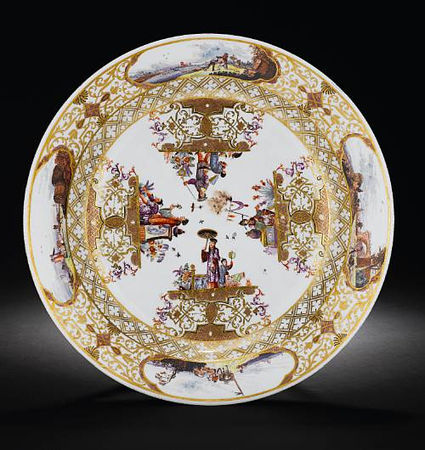







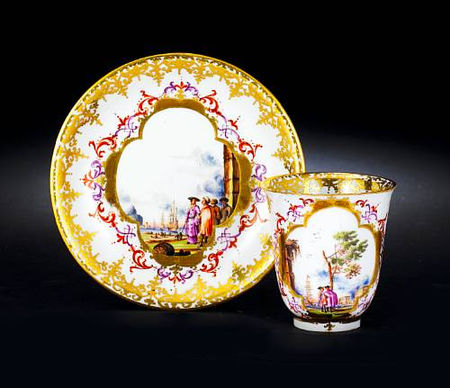


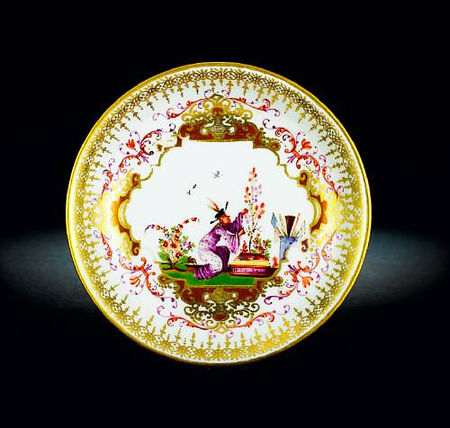
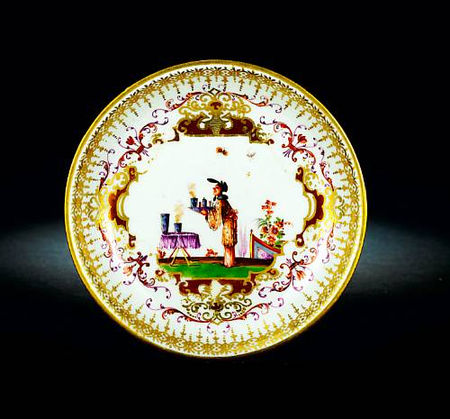
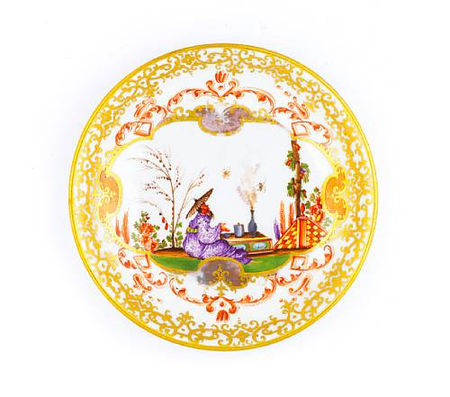
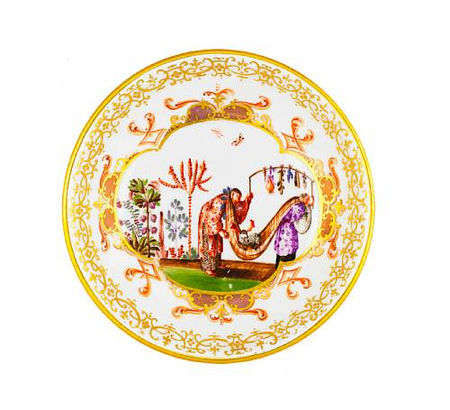





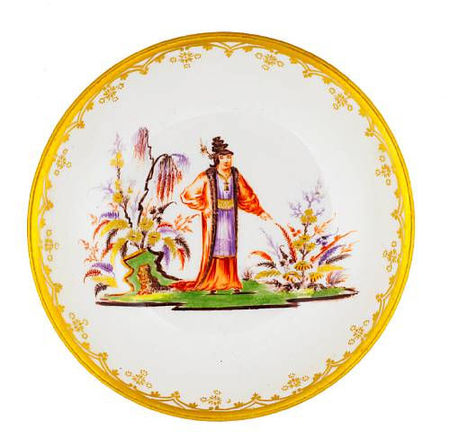


/http%3A%2F%2Fstorage.canalblog.com%2F63%2F85%2F119589%2F66261880_p.jpg)
/http%3A%2F%2Fstorage.canalblog.com%2F13%2F05%2F119589%2F66261326_p.jpg)
/http%3A%2F%2Fstorage.canalblog.com%2F43%2F98%2F577050%2F66241613_o.jpg)
/http%3A%2F%2Fstorage.canalblog.com%2F20%2F23%2F119589%2F66152064_p.jpg)